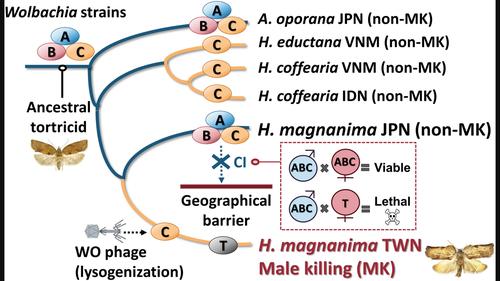当前位置:
X-MOL 学术
›
Environ. MicroBiol. Rep
›
论文详情
Our official English website, www.x-mol.net, welcomes your feedback! (Note: you will need to create a separate account there.)
Conserved infections and reproductive phenotypes of Wolbachia symbionts in Asian tortrix moths
Environmental Microbiology Reports ( IF 3.3 ) Pub Date : 2023-12-09 , DOI: 10.1111/1758-2229.13219 Hiroshi Arai, Masatoshi Ueda, Tatsuya Hirano, Naoya Akizuki, Shiou-Ruei Lin, Duong Kieu Hanh, Jaka Widada, Muhammad Saifur Rohman, Madoka Nakai, Yasuhisa Kunimi, Le Van Vang, Arman Wijonarko, Maki N. Inoue
Environmental Microbiology Reports ( IF 3.3 ) Pub Date : 2023-12-09 , DOI: 10.1111/1758-2229.13219 Hiroshi Arai, Masatoshi Ueda, Tatsuya Hirano, Naoya Akizuki, Shiou-Ruei Lin, Duong Kieu Hanh, Jaka Widada, Muhammad Saifur Rohman, Madoka Nakai, Yasuhisa Kunimi, Le Van Vang, Arman Wijonarko, Maki N. Inoue

|
Wolbachia is a ubiquitous endosymbiotic bacterium that manipulates insect reproduction. A notable feature of Wolbachia is male killing (MK), whereby sons of infected females are killed during development; however, the evolutionary processes by which Wolbachia acquired the MK ability remain unclear. The tea tortrix moth Homona magnanima (Tortricidae) harbours three non-MK Wolbachia strains (wHm-a, wHm-b and wHm-c) and an MK strain wHm-t. Although wHm-t and wHm-c are closely related, only wHm-t has an MK-associated prophage region. To understand the evolutionary processes underlying the emergence of MK wHm-t, we examined Wolbachia infections and phenotypes in 62 tortricid species collected from 39 localities across Japan, Taiwan, Vietnam and Indonesia. PCR assays detected wHm-c relatives in 51 species and triple infection of wHm-a, wHm-b and wHm-c in 31 species. Apart from Taiwanese H. magnanima, no species exhibited the MK phenotype and were positive for the wHm-t-specific prophage. While wHm-t infection was dominant in Taiwanese H. magnanima, wHm-a, wHm-b and wHm-c were dominant in Japanese H. magnanima populations. These results suggest that wHm-a, wHm-b and wHm-c strains descended from a common ancestor with repeated infection loss and that wHm-t evolved from the wHm-c acquiring MK ability in allopatric populations of H. magnanima.
更新日期:2023-12-09



























 京公网安备 11010802027423号
京公网安备 11010802027423号